The plants commonly known as umbellifers were renamed in 2011, changing ‘Umbelliferae’ to ‘Apiaceae’. This reflects a broader trend to standardise and clarify scientific plant family names. The original name is still used by many, as it highlights one of the most recognisable characteristics, their ‘umbrella-shaped’ flower heads. ‘Umbellifer’ is a useful catchall term for those referring to this group of plants as the ‘carrot’, ‘parsley’ or ‘celery’ family. However, not all types of Apiaceae are delicious or edible, there is a need to also identify poisonous umbellifers in the UK.
Umbellifer and Apiaceae family history
The name ‘Apiaceae’ has roots in Latin, where ‘apium’ is believed to refer to celery. Apiaceae – the family name – is derived from the genus Apium. The species of which, include celery (Apium graveolens) and parsley (Petroselinum crispum). The term ‘apium’ be traced back a long way, over 2000 years.
The alternative name, Umbelliferae, comes from the Latin ‘umbella’ (little shadow) and ‘ferre’ (meaning ‘to bear’). The name was established based on the common appearance of many Apiaceae flowers, their umbrella-like appearance. Despite the widespread usage of both names, Apiaceae is now the one officially recognised one.
The Apiaceae Family of Plants
The Apiaceae family is large and diverse, the science publication Horticulture Research references 434 genera and nearly 3780 species. This family includes many economically important crop vegetables such as celery, carrots, and parsnips, as well as a variety of aromatic herbs like parsley, coriander and fennel.
However, some members of the Apiaceae family, like hemlock (conium maculatum), can be fatally poisonous. Whilst the the Apiaceae family of plants is extensive, many species share very similar characteristics. Comparable stems, leaf shapes and colouration can make it very hard to identify one species of Apiaceae from another.
The consequences of misidentifying and eating poisonous Apiaceae can lead to illness or even death. For example, the young leaves of cow parsley (Anthriscus sylvestris) are edible, but look similar to those of hemlock, as well as fool’s parsley (Aethusa cynapium), both of which are harmful, or fatal, if eaten.
What types of Apiaceae are in the UK?
Many types of Apiaceae can be found in the UK, encompassing both native and naturalised plants. A wide range of species that comprises of annuals, biennials, and even perennial herbs. Valuable for their ecological roles, culinary uses, or ornamental qualities. However, also renowned because some contain toxic compounds that are extremely hazardous.
Poisonous Umbellifers found in the UK:
Hemlock Water-dropwort (Oenanthe crocata)
Cowbane (Cicuta virosa)
Rough Chervil (Chaerophyllum temulum)
Hogweed (Heracleum sphondylium)
Other Umbellifers of the British Isles:
Ground elder (Aegopodium podagraria)
Cow parsley (Anthriscus sylvestris)
Subfamilies of Apiaceae
The term Apiaceae refers to a grouping of plants at the family level. This can be broken down further through various levels down to a single ‘species’. At family level, a group of plants will very broadly share a set of characteristics, like the leaf arrangement for example.
Moving on through the levels like ‘subfamily’ and into species, these traits becoming less widely shared and eventually, may be held by only one example.
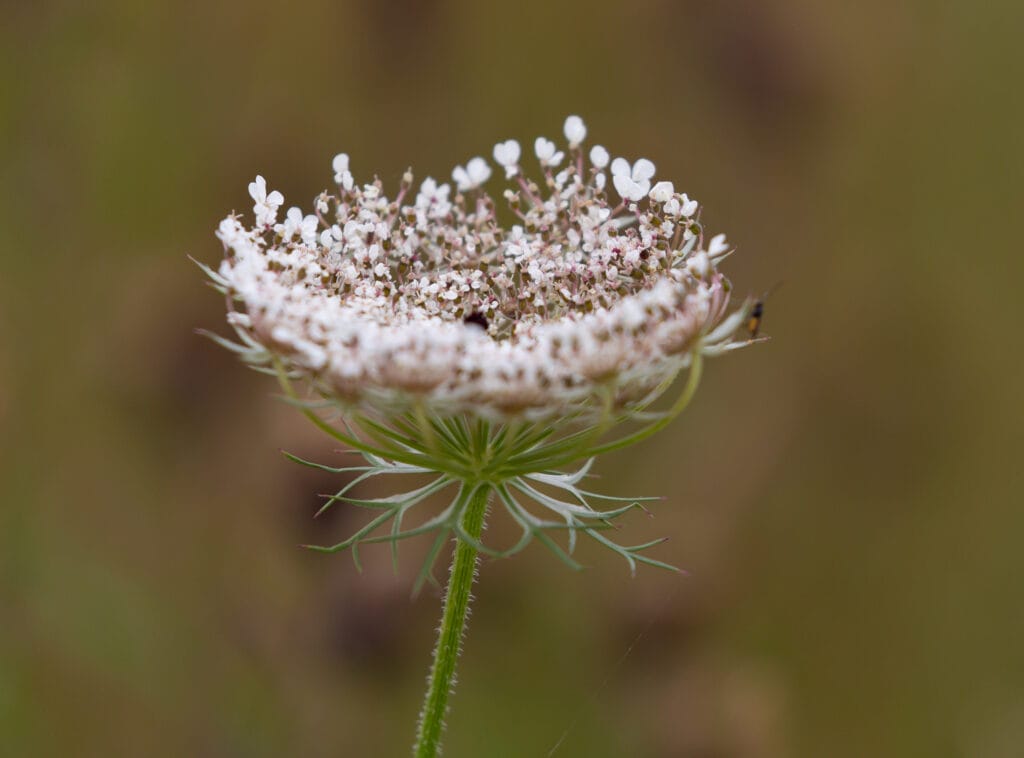
The flower of Queen Anne’s Lace iStock/Wirestock
‘Queen Anne’s Lace’ is an umbellifer that has delicate, finely cut leaves similar to many other related plants. However, the central flower within the flower umbel (group) of flowers is often red or purple, with all the others being white. No other member of the genus has this trait, and so it is a species apart from all others – Daucus carota.
- Apioideae: This is the largest subfamily and includes many well-known herbs and spices such as parsley (Petroselinum crispum), carrot (Daucus carota), celery (Apium graveolens), and fennel (Foeniculum vulgare).
- Saniculoideae: This subfamily includes sanicle (Sanicula europaea) and other mostly woodland species. Plants in this subfamily are generally characterised by inflorescences that are not typical umbels.
- Hydrocotyloideae: This subfamily is known for including plants like pennywort (Hydrocotyle) and related genera. These plants are usually found in wet or damp environments.
Breaking down plant groups in this way allows for a detailed and precise way to classify, identify and study different plants.
Umbellifer Identification in the UK
Umbellifer identification in the UK can be challenging because so many family species share similar characteristics. You don’t have to go far to find an umbellifer either. It is extremely common to find them in hedgerows, or along road verges and waterways. Perhaps the best place to start breaking down Apiaceae identification, is with the identifier that named them in the first place, the flowers.
Umbellifer flowers
The umbel is a group or cluster of flowers, arranged into a shape that resembles an umbrella. An umbel is usually made up of many small flowers. Sometimes, umbels themselves are grouped together, forming a compound umbel. Umbellifer flowers will have five petals and are most commonly white, with cream or yellow flowers being the next most common. Pink and purple flowers are the rarest, seen on plants such as Pimpinella major (greater burnet-saxifrage).
Other Apiaceae Characteristics
Umbellifer leaves typically provide more variety than the flowers. Many have finely divided leaves that give the plants a soft, lacy or fern-like appearance. However, this isn’t always the case, Giant hogweed leaves are deeply divided, their overall look is sharp and pointy (as well as being huge). Another potential umbellifer identifier, is if the leaves are arranged alternately from the main stem i.e. the leaf stems aren’t growing opposite each other.
Umbellifer stems
Most umbellifer stems are ‘fleshy’, which is typically true of herbaceous plants general. Other tell-tale signs are, grooves or ridges along the length of the stem. In the case of celery there is one single, deep groove.
Stems can be hairy or smooth to the touch. And, many umbellifers display marked colouration on all or parts of their stems, which is often spotted or blotchy. A commonly shared umbellifer characteristic is a hollow ‘noded’ stem, with papery sheaths around the base of side stems.
Of course, there are exceptions to all of the above, and because some umbellifers are poisonous, it’s always best to simply observe and not touch.
Poisonous Umbellifers
It’s useful to know some of the key poisonous umbellifers that can be found in the UK. This is particularly pertinent when the toxins of some species can damage skin and the ingestion of others could lead to death.
Poison Hemlock (Conium maculatum)
This is the plant that is thought by many to have been used to kill Socrates. Conium maculatum is a plant you don’t want to mess around with. Striking in appearance, with its tall, purple-blotched stems set against bright green, fern-like leaves, it is also extremely common in the UK, where it is native. It can be invasive given the chance, and loves waste ground, road verges, wet ditches, streams and riverbanks. There is no specific legislation mandating the control of Hemlock in the the UK. However, there is the general principle of ‘duty of care’, and the need to manage land in a way that does not pose a risk to human health or safety. Hemlock has the potential to pose a threat to the safety of people and animals if ingested.
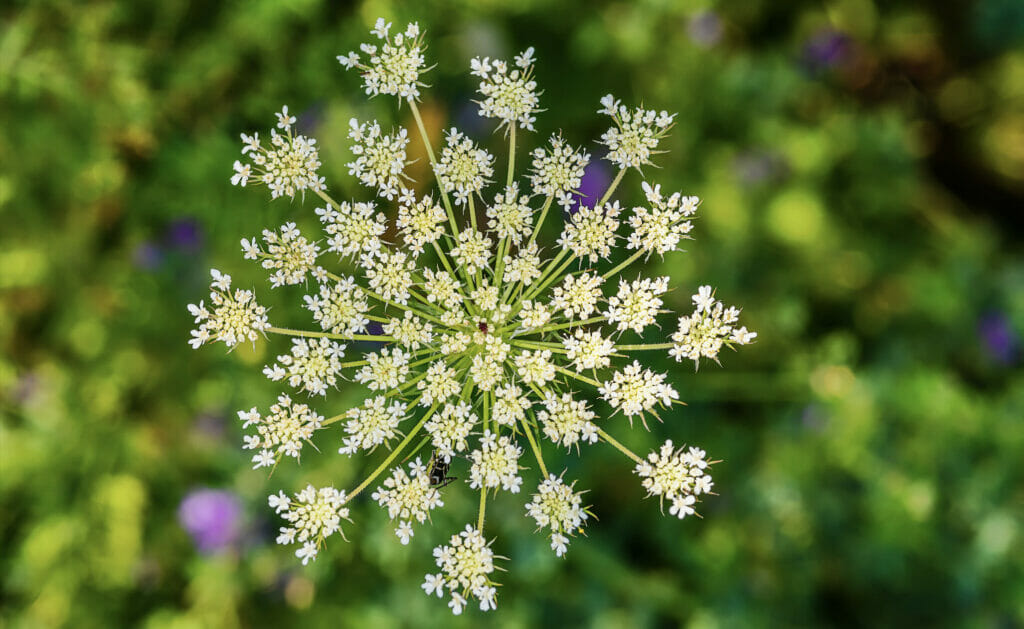
Poison Hemlock flower head | Photo 193461511 / Hemlock Plant © Nenad Nedomacki | Dreamstime.com
Hemlock Water-dropwort (Oenanthe crocata)
Oenanthe crocata takes things a step further than its cousin, poison hemlock. One of eight Oenanthe species, it takes the dubious honour of being the most poisonous plant in the UK. Again, it’s extremely common, meaning that you’ve probably walked straight past it while rambling along a stream out in the countryside. It’s leaves are slightly fuller looking than those of Conium maculatum and the green, main stem doesn’t have the fearsome looking purple-red streaks. When cut or crushed, the plant gives off a smell reminiscent of parsley and celery, but also with a hint of petrol.
Parsley Water-dropwort and Tubular Water-dropwort are also UK found species from the Oenanthe genus. Members of this genus have typically an affinity for wet habitats such as ditches, marshes, and riverbanks. And, whilst they share similarities in appearance with other Apiaceae family members, their high toxicity sets them apart.
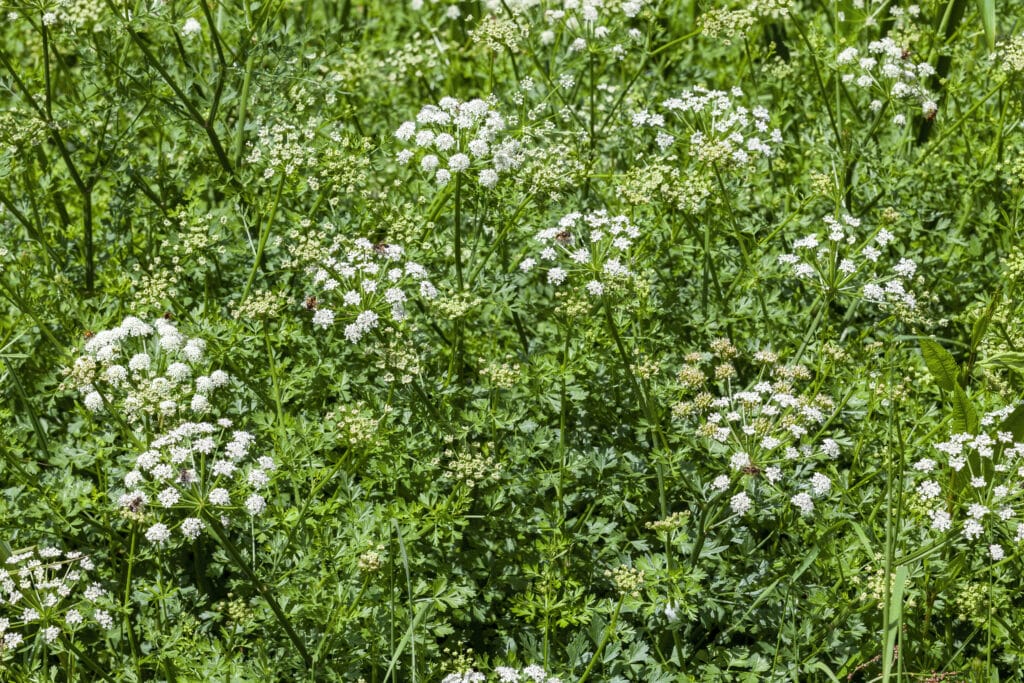
Oenanthe crocata, Hemlock Water Dropwort iStock/TonyBaggett
Cowbane (Cicuta virosa)
Also known, somewhat confusingly, as ‘northern water hemlock’. This deadly umbellifer is best identified with a cut stem, which would reveal a yellow liquid. However, as this oily looking sap is highly poisonous, it is not recommended that this plant is cut or touched. Cowbane is only slightly less poisonous than Hemlock water dropwort, ingestion is likely to lead to critical health issues or death. The grooved, green stems also have another feature which sets cowbane apart from most other umbellifers, this being a flat ‘side’ within the rounded main stem shape. You’re not so likely to come across water hemlock in the UK, with its rarity perhaps being its best feature from a human perspective.
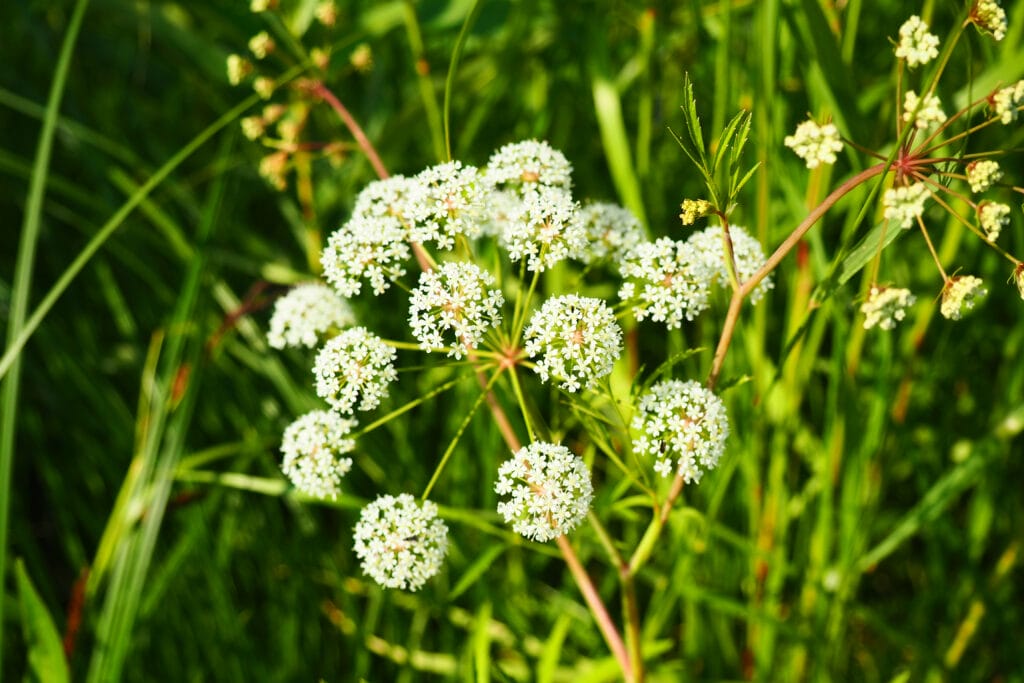
The flowers of Cowbane (Cicuta virosa) iStock/Iuliia Petrovskaia
Rough Chervil (Chaerophyllum temulum)
Another poisonous umbellifer that is common in the UK. The similarity of rough chervil to wild chervil means it can easily be foraged by mistake with nasty, though not typically fatal, results. Growing to about one metre in height, it’s one of the earliest Apiaceae to flower. The stems have the purple spots similar to hemlock but are hairy and have noticeable swellings at the nodes (or joints). Although the serrated or divided leaves are tapered and look similar to hemlock leaves, they have soft hairs on both sides. Symptoms after ingestion can include drowsiness and vertigo, stomach inflammation and, sometimes, heart issues.
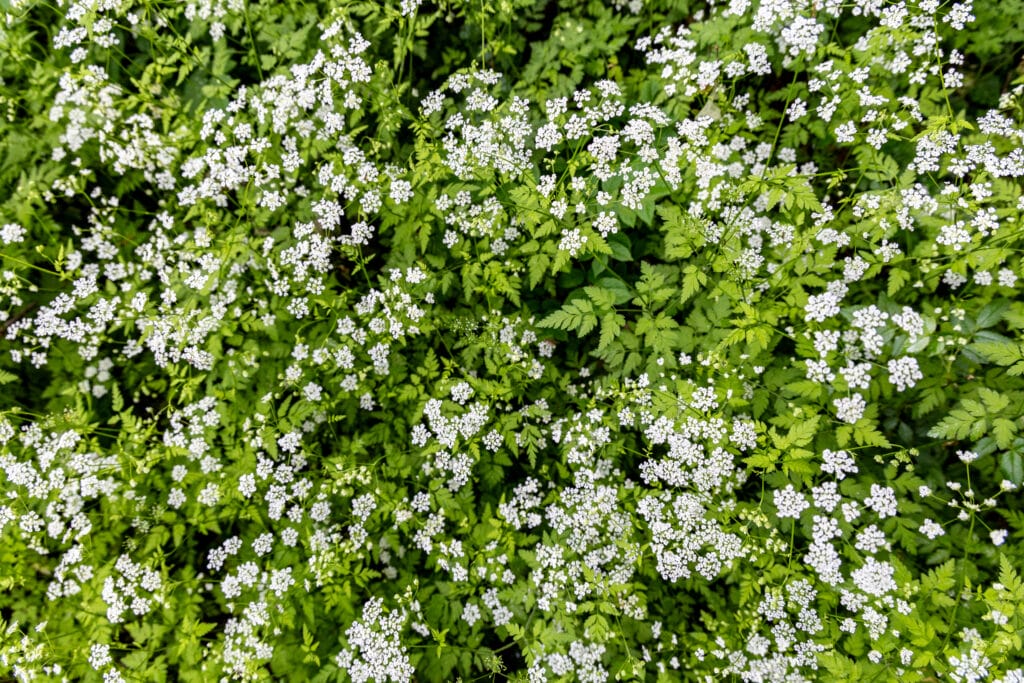
Rough chervil flowers, Chaerophyllum temulum iStock/v_zaitsev
Hogweed (Heracleum sphondylium)
Often known as common hogweed, Heracleum sphondylium is one of the most prolific umbellifers of the British Isles. Reported as being present across almost the entire UK landscape, common hogweed is a native plant and relative of the impressive but dangerous, Giant hogweed. While both plants contain sap that can irritate the skin to some degree, the sap of giant hogweed is particularly dangerous. It contains furanocoumarins, which can cause severe skin burns when exposed to sunlight. This is a critical distinction from common hogweed, whose sap can cause mild irritation but generally does not lead to severe photodermatitis as giant hogweed sap does. There are complexities involved in managing this troublesome relation, including health and safety, waste disposal, and legal responsibilities. For this reason, professional assistance is usually required for giant hogweed control and removal.
Common hogweed may have got the name due to the practice of giving it to pigs as fodder as it was (and still is) so prolific in the countryside. Growing to heights of around 1.5 to 2 metres, it has hollow, hairy stems that are green but may have a smooth purple tint. The leaves are divided quite deeply but in a smooth or rounded way, unlike the sharp, spiky looking divisions to look out for when identifying giant hogweed. The flower umbels will grow up to around 20 cm across and are generally composed of a mass of off-white flowers. You’ll find common hogweed growing happily along hedges, verges, streams and rivers, while it’s not averse to colonising waste ground either.
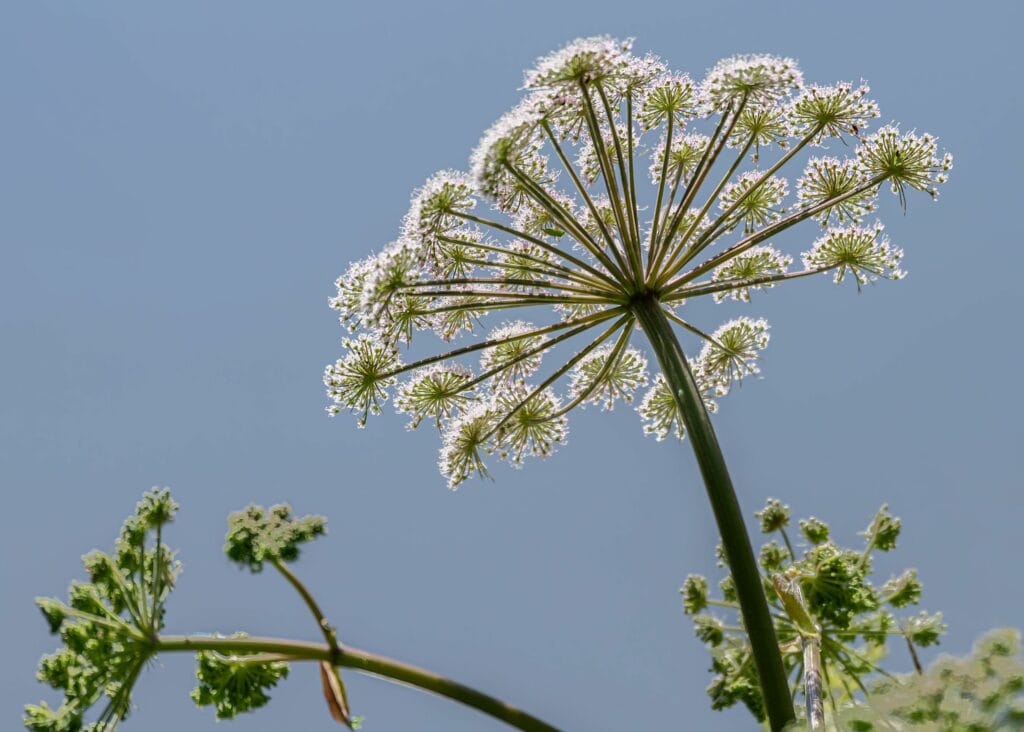
Common Hogweed Flower head from underneath
Other Umbellifers of the British Isles
While you’ll find different opinions on this, it seems generally accepted that the number of umbellifers of the British Isles is around 50. That’s quite a lot to remember if you want to be able to identify them all! The range of sizes and leaf shapes, stem colours and markings is diverse. However, the one feature that brings this range of plants together is the umbel, the name given to the umbrella-shaped flower heads that are such a common sight during the British summertime. Here we take a look at a few more of these fascinating plants.
Wild carrot (Daucus carota)
Thought to be the ancestor of all edible carrot varieties, Daucus carota is a biennial that is found in the wild in the UK, more commonly around the costal areas of the south. The taproot will give off a very familiar ‘carroty’ smell if it is cut or crushed but are very coarsely textured, sometimes being described as woody by those who have tried to eat them. With the classic frothy white umbel of flowers, wild carrot can be identified by the singular red or purple flower that appears in the centre of each umbel. The leaves are very finely divided, giving a soft, ferny appearance.
It’s worth noting that livestock can be poisoned by eating large quantities of wild carrot, as the sap contains chemicals known as furanocoumarins, which can cause photosensitization in the skin. In particular, on sunny days, if an animal has consumed enough wild carrot, skin blistering and inflammation can occur, which can result in long-term damage.
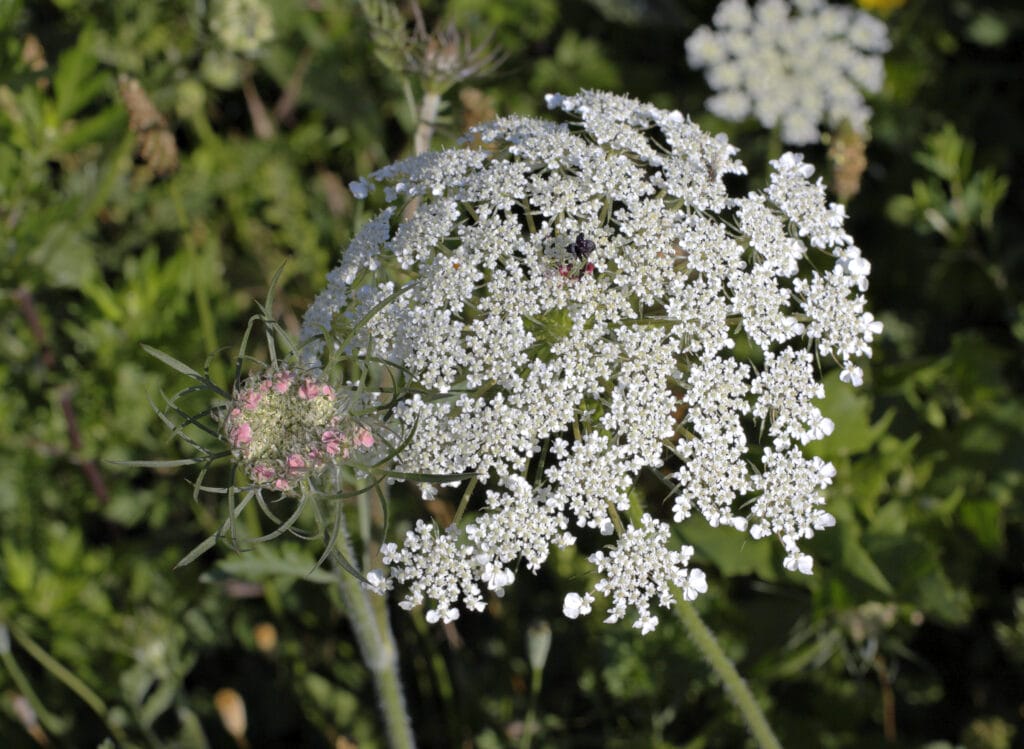
Wild carrot Daucus carota with birds nest wildflower iStock/Whiteway
Ground elder (Aegopodium podagraria)
Ground elder is an extremely common umbellifer in the UK, as well as being a potentially troublesome pest in gardens. The plant can spread very quickly using underground stems, and once established ground elder removal can be difficult. Not strictly native to the UK, Aegopodium podagraria has been naturalised, and is loved by native pollinating insects. There are culinary uses for humans too, with the young leaves being used in salads and soups. However, given the similarities between the many types of types of apiaceae in the UK, cautious examination is required when identifying ground elder.
N.B. Misidentification is a common risk when foraging for wild plants. Ground elder can be confused with other plants that are not edible or are toxic. It’s crucial to be 100% certain of the plant’s identity before consuming it.
Ground elder is commonly found in shaded or part-shaded areas such as the edges of woodland and in verges. The plant forms a green carpet of ground cover until the flowering stems rise higher, reaching up to around a metre and pushing out a canopy of many bright white flowers on a sea of umbels.
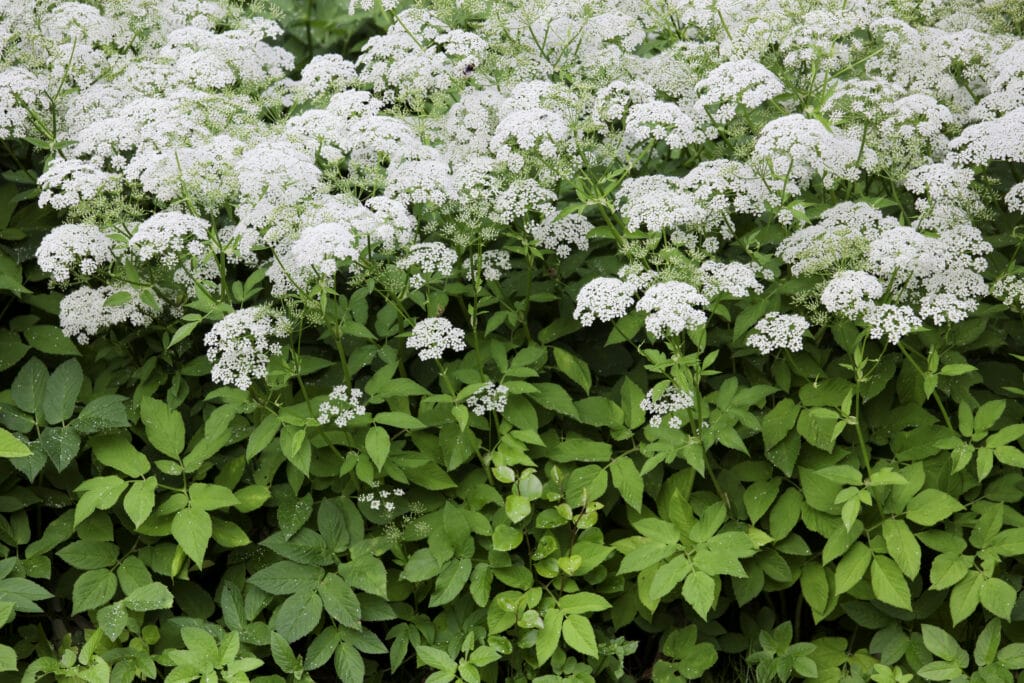
Ground-elder (Aegopodium podagraria) in flower iStock/LordRunar
Cow parsley (Anthriscus sylvestris)
Cow parsley is perhaps one of the best-known wild plants in the British Isles, at least by name. Identifying cow parsley can be confusing, because the umbellifer family of plants has so many lookalikes. Also known as wild chervil, cow parsley is UK native commonly seen on walks through the countryside, in verges, hedges, and along paths and waterways.
Although the young leaves and flower heads are considered edible, the similarities to poison hemlock (particularly the leaf shape) are so strong that foraging for cow parsley is not recommended. However, there are differences that can be spotted between these two plants. Cow parsley has hairy leaf stems, whilst those of hemlock are smooth. And, the stems in cross-section are also different, with cow parsley having a shape akin to a capital ‘D’ and hemlock’s being rounded.
Of course, you don’t need to try to eat cow parsley to admire it. In the spring and early summer, the endless flowers adorning the roadside verges are a treat for us all.
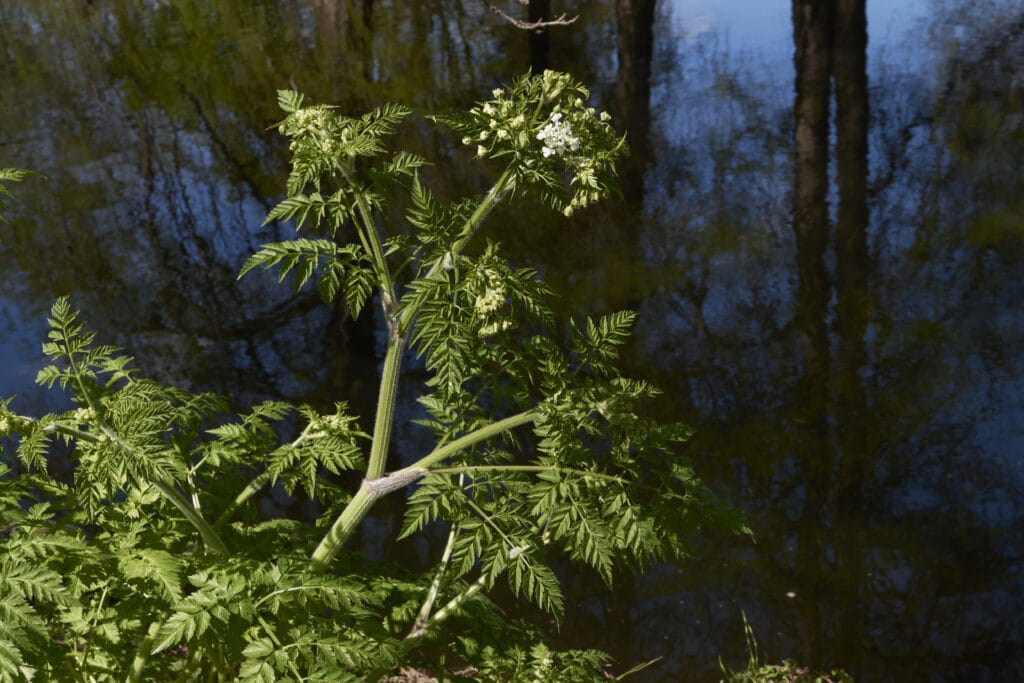
Cow Parsley (Antheriscus sylvestris) in bloom iStock/seven75
If you concerned about, poison hemlock, Giant Hogweed, ground elder or any of the troublesome or poisonous umbellifers call 0203 174 2187 or 01202 816134 to talk to one of our consultants today.
Wild carrot flowers in bloom
Lead image iStock/PatrikStedrak

